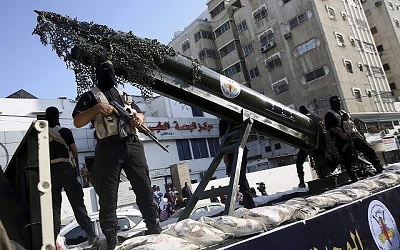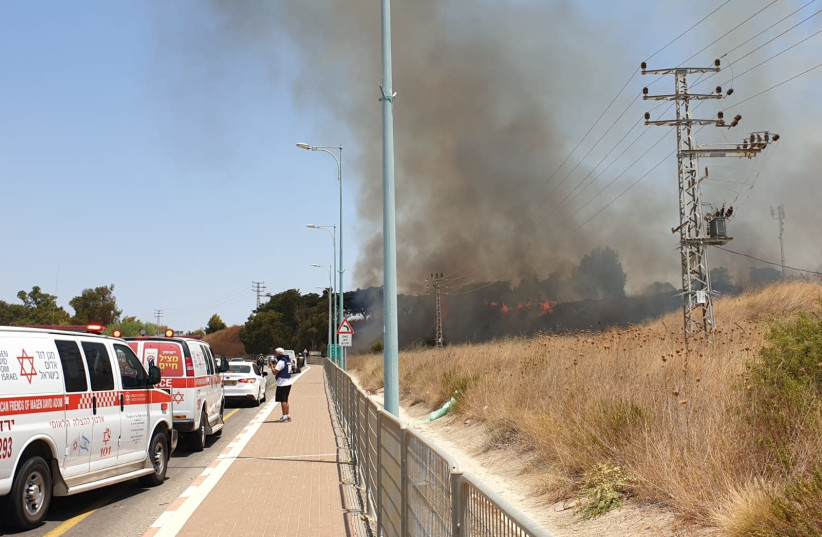
 Palestyńczycy oskarżają Hamas o magazynowanie broni na cywilnych terenach
Palestyńczycy oskarżają Hamas o magazynowanie broni na cywilnych terenach
Hugh Fitzgerald
Tłumaczenie: Małgorzata Koraszewska
Daje pewną satysfakcję potwierdzenie wielokrotnych twierdzeń Izraela, że Hamas umyślnie magazynuje broń w dzielnicach mieszkalnych, przychodzące obecnie od samych Palestyńczyków – a mianowicie, od 133 palestyńskich NGO, które potępiły niebezpieczne i okrutne działania Hamasu. Pisze o tym Khaled Abu Toameh w artykule z 24 lipca 2021 roku w “Jerusalem Post”, Palestinians accuse Hamas of storing weapons in residential areas [Palestyńczycy oskarżają Hamas o magazynowanie broni na terenach mieszkalnych]:
Palestyńskie grupy i organizacje praw człowieka wezwały Hamas i inne palestyńskie grupy terroru, by przestały magazynować broń w dzielnicach mieszkalnych po kolejnej eksplozji w czwartek [21 lipca], która zabiła jedną osobę i raniła 14 innych.
Żądają także dogłębnego śledztwa w sprawie eksplozji w celu pociągnięcia winnych do odpowiedzialności.
Palestyńczycy w Strefie Gazy mówią, że eksplozja zdarzyła się w magazynie, gdzie Hamas przechowywał amunicję.
“Magazynem” był w rzeczywistości zwykły, trzypiętrowy dom mieszkalny przy targu z żywnością Al-Zawija w środku dzielnicy mieszkalnej Gazy. Wokół domu zawsze były dziesiątki cywilów.
Hamas powiedział, że rozpoczął dochodzenie w sprawie eksplozji, ale nie podał żadnych szczegółów…
“Centrum Al-Mezan Praw Człowieka w Gazie traktuje eksplozję z wielką powagą, ponieważ w przeszłości zdarzały się już wielokrotnie eksplozje w domach w przeludnionych dzielnicach, w wyniku których zginęło wielu cywilów i zniszczono budynki publiczne i prywatne” – brzmi oświadczenie.
Od Palestyńczyków, z pierwszej ręki: “w przeszłości zdarzały się już wielokrotnie eksplozje w domach w przeludnionych dzielnicach” w wyniku których “zginęło wielu cywilów”. To nie była pierwsza taka eksplozja w magazynie broni Hamasu, a tylko najnowsza z wielu, a wszystkich można było uniknąć, gdyby ta grupa terrorystyczna umieszczała swoją broń z dala od dzielnic mieszkalnych. Jednak ta grupa terrorystyczna zawsze starała się maksymalizować zagrożenie dla palestyńskich cywilów przez magazynowanie broni wśród nich w nadziei uniknięcia izraelskich ataków.
“Zatem Al-Mezan powtarza wezwanie do wszechstronnego i poważnego śledztwa tego wydarzenia i innych podobnych wydarzeń, opublikowania wyników śledztwa i podjęcia niezbędnych kroków, by zapewnić, że nie powtórzy się to, w celu zachowania życia i własności obywateli”.
“Niezbędne kroki, by zapewnić, że to [taka eksplozja] nie powtórzy się” oznaczają, że musiano by dokonać całkowitej zmiany magazynowania broni przez Hamas. Broń musiałaby być zabrana z zamieszkałych miejsc i umieszczona daleko od cywilnych obszarów – gdzie oczywiście łatwiej odkryje ją izraelskie lotnictwo – IAF.
Palestyńska Sieć NGO, organizacja parasolowa, która obejmuje 133 organizacje członkowskie, wezwała także do “poważnego i przejrzystego” dochodzenia w sprawie samej eksplozji. „Sieć podkreśliła potrzebę przyspieszenia pomocy i wsparcia we wszystkich postaciach dla poszkodowanych”. Podkreśliła także potrzebę „ogłoszenia wyników dochodzenia i podjęcia poważnych kroków, by nie dopuścić kiedykolwiek do dalszych takich eksplozji”….
Wygląda na to, że Palestyńczycy są u kresu wytrzymałości i mają dość praktyki Hamasu umyślnego umieszczania magazynów broni i amunicji pośrodku zamieszkałych terenów, gdzie niebezpieczeństwo niezamierzonych eksplozji i cywilnych ofiar jest wysokie. I teraz pokazują publicznie swoją tłumioną wcześniej wściekłość, mimo że ich skarga o grupie terroru praktycznie rzecz biorąc powtarza i podtrzymuje oskarżenia wysuwane przez Izrael przeciwko Hamasowi.
Fadel Al-Manasfeh, palestyński autor, powtarza słowa Izraelczyków: „Hamas wybiera popularne miejsca jako bezpieczne miejsca dla swoich magazynów amunicji, ponieważ wie, że Izrael nie uderza w takie miejsca”. Izraelczycy starają się celować precyzyjnie w magazyny broni, żeby zminimalizować ofiary cywilne, a przed atakiem IDF ostrzega cywilów, by opuścili przyległe miejsca – telefonami, emailami i techniką “stukania w dach”. Nie wszyscy cywile zawsze odchodzą w porę, a czasami spodziewana precyzja zawodzi. Izrael jednak nigdy nie “uderza” umyślnie w cywilne obszary. Al-Manasfeh ma rację: “Izrael nie uderza w takie miejsca” jak “popularne centra handlowe”, gdzie Hamas magazynuje swoją amunicję i broń.
Kiedy następnym razem państwo żydowskie zostanie zaatakowane na Zgromadzeniu Ogólnym ONZ, ambasador Izraela powinien przeczytać ten artykuł z “Jerusalem Post”, zaznaczyć, że to sami Palestyńczycy oskarżyli Hamas o umyślne składowanie broni na cywilnych terenach w nadziei, że albo Izrael będzie musiał powstrzymać się od atakowania ich, albo – jeśli zdecyduje się zaatakować – wszystkie cywilne ofiary, jakie z tego wynikną (Hamasu nie obchodzi ich los) pogorszą wizerunek Izraela. Niech ambasador przeczyta Zgromadzeniu Ogólnemu, co Centrum Praw Człowieka Al Mezan ma do powiedzenia o tej najnowszej eksplozji w domu pośrodku targu Al-Zawija i dlaczego 133 palestyńskie NGO żąda dogłębnego dochodzenia i co palestyński pisarz, Fadel Al-Manasfeh powiedział o praktyce terrorystycznej grupy Hamas umyślnego umieszczania broni na cywilnych terenach (takich jak targi), ponieważ wie, że jest mało prawdopodobne, by Izrael tam atakował. Po przeczytaniu tego – cytując tylko samych Palestyńczyków – może powiedzieć osłupiałemu Zgromadzeniu (i wściekłemu delegatowi „Państwa Palestyna”), że „Nie mam nic więcej do dodania”.
Hugh Fitzgerald – Publicysta Jihad Watch
Zawartość publikowanych artykułów i materiałów nie reprezentuje poglądów ani opinii Reunion’68,
ani też webmastera Blogu Reunion’68, chyba ze jest to wyraźnie zaznaczone.
Twoje uwagi, linki, własne artykuły lub wiadomości prześlij na adres:
webmaster@reunion68.com





